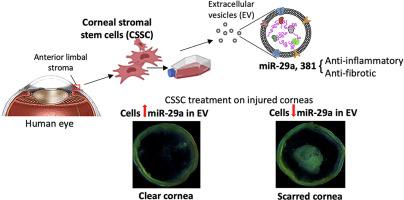Journal of Advanced Research ( IF 11.4 ) Pub Date : 2022-05-25 , DOI: 10.1016/j.jare.2022.05.008 Gary Hin-Fai Yam 1 , Tianbing Yang 2 , Moira L Geary 2 , Mithun Santra 2 , Martha Funderburgh 2 , Elizabeth Rubin 2 , Yiqin Du 1 , Jose A Sahel 1 , Vishal Jhanji 1 , James L Funderburgh 2

|
Introduction
Corneal blindness due to scarring is treated with corneal transplantation. However, a global problem is the donor material shortage. Preclinical and clinical studies have shown that cell-based therapy using corneal stromal stem cells (CSSCs) suppresses corneal scarring, potentially mediated by specific microRNAs transported in extracellular vesicles (EVs). However, not every CSSC batch from donors achieves similar anti-scarring effects.
Objectives
To examine miRNA profiles in EVs from human CSSCs showing “healing” versus “non-healing” effects on corneal scarring and to design a tool to select CSSCs with strong healing potency for clinical applications.
Methods
Small RNAs from CSSC-EVs were extracted for Nanostring nCounter Human miRNA v3 assay. MicroRNAs expressed > 20 folds in “healing” EVs (P < 0.05) were subject to enriched gene ontology (GO) term analysis. MiRNA groups with predictive regulation on inflammatory and fibrotic signalling were studied by mimic transfection to (1) mouse macrophages (RAW264.7) for M1 phenotype assay; (2) human corneal keratocytes for cytokine-induced fibrosis, and (3) human CSSCs for corneal scar prevention in vivo. The expression of miR-29a was screened in additional CSSC batches and the anti-scarring effect of cells was validated in mouse corneal wounds.
Results
Twenty-one miRNAs were significantly expressed in “healing” CSSC-EVs and 9 miRNA groups were predicted to associate with inflammatory and fibrotic responses, and tissue regeneration (P <10−6). Overexpression of miR-29a and 381-5p significantly prevented M1 phenotype transition in RAW264.7 cells after lipopolysaccharide treatment, suppressed transforming growth factor β1-induced fibrosis marker expression in keratocytes, and reduced scarring after corneal injury. High miR-29a expression in EV fractions distinguished human CSSCs with strong healing potency, which inhibited corneal scarring in vivo.
Conclusion
We characterized the anti-inflammatory and fibrotic roles of miR-29a and 381-5p in CSSCs, contributing to scar prevention. MiR-29a expression in EVs distinguished CSSCs with anti-scarring quality, identifying good quality cells for a scarless corneal healing.
中文翻译:

人角膜基质干细胞表达抗纤维化 microRNA-29a 和 381-5p – 用于角膜疤痕干细胞治疗的强大细胞选择工具
介绍
由于疤痕造成的角膜失明可以通过角膜移植来治疗。然而,一个全球性问题是捐赠物资短缺。临床前和临床研究表明,使用角膜基质干细胞 (CSSC) 的细胞疗法可抑制角膜疤痕形成,这可能是由细胞外囊泡 (EV) 中运输的特定 microRNA 介导的。然而,并非每批捐赠者的 CSSC 都能达到类似的抗疤痕效果。
目标
检查人类 CSSC 的 EV 中的 miRNA 谱,显示对角膜疤痕的“愈合”与“非愈合”作用,并设计一种工具来选择具有强愈合能力的 CSSC 进行临床应用。
方法
从 CSSC-EV 中提取小 RNA 用于 Nanostring nCounter Human miRNA v3 测定。在“愈合”EV 中表达超过 20 倍的 MicroRNA(P < 0.05)接受富集基因本体(GO)术语分析。通过模拟转染至 (1) 小鼠巨噬细胞 (RAW264.7) 进行 M1 表型测定,研究了对炎症和纤维化信号传导具有预测调节作用的 miRNA 组; (2)人角膜角膜细胞用于细胞因子诱导的纤维化,以及(3)人CSSC用于体内角膜疤痕预防。在额外的 CSSC 批次中筛选了 miR-29a 的表达,并在小鼠角膜伤口中验证了细胞的抗疤痕作用。
结果
21 个 miRNA 在“愈合”CSSC-EV 中显着表达,9 个 miRNA 组预计与炎症和纤维化反应以及组织再生相关(P <10 id=6>−6 )。脂多糖处理后,miR-29a和381-5p的过表达显着阻止RAW264.7细胞中的M1表型转变,抑制转化生长因子β1诱导的角膜细胞中纤维化标志物的表达,并减少角膜损伤后的疤痕形成。 EV 部分中的高 miR-29a 表达使人类 CSSC 具有强大的愈合能力,可抑制体内角膜疤痕形成。
结论
我们表征了 miR-29a 和 381-5p 在 CSSC 中的抗炎和纤维化作用,有助于预防疤痕。 EV 中的 MiR-29a 表达使 CSSC 具有抗疤痕质量,从而识别出用于无疤痕角膜愈合的优质细胞。










































 京公网安备 11010802027423号
京公网安备 11010802027423号